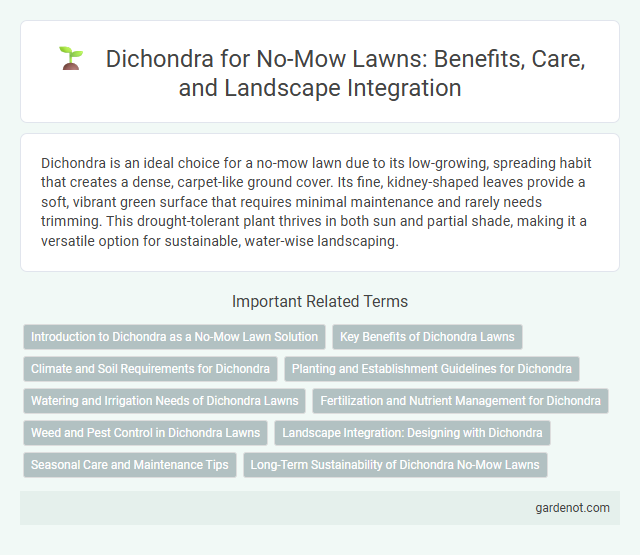Dichondra is an ideal choice for a no-mow lawn due to its low-growing, spreading habit that creates a dense, carpet-like ground cover. Its fine, kidney-shaped leaves provide a soft, vibrant green surface that requires minimal maintenance and rarely needs trimming. This drought-tolerant plant thrives in both sun and partial shade, making it a versatile option for sustainable, water-wise landscaping.
Introduction to Dichondra as a No-Mow Lawn Solution
Dichondra is a low-growing, spreading groundcover native to warm climates, known for its lush, small, kidney-shaped leaves and carpet-like appearance. Its tolerance to drought and minimal mowing requirements make it an ideal no-mow lawn alternative, significantly reducing maintenance efforts compared to traditional grass lawns. Dichondra thrives in USDA zones 8-11, providing a durable, green lawn solution that conserves water and supports eco-friendly landscaping.
Key Benefits of Dichondra Lawns
Dichondra lawns offer exceptional drought tolerance and require significantly less water than traditional grass, making them ideal for water-conscious landscapes. Their low-growing, dense foliage provides excellent weed suppression and reduces the need for mowing, saving time and maintenance costs. Additionally, Dichondra's soft texture creates a lush, carpet-like appearance that enhances aesthetic appeal while supporting eco-friendly gardening practices.
Climate and Soil Requirements for Dichondra
Dichondra thrives in warm, temperate climates with mild winters and moderate rainfall, making it ideal for USDA zones 7 to 11. It prefers well-drained, sandy to loamy soils with a slightly acidic to neutral pH between 6.0 and 7.0. This low-growing ground cover demands minimal soil fertility but benefits from loose, aerated soil to promote healthy root development.
Planting and Establishment Guidelines for Dichondra
Dichondra thrives in well-drained, sandy or loamy soils with a pH range of 6.0 to 7.5, requiring full sun to partial shade for optimal growth. Plant seeds or plugs in spring or early summer when soil temperatures consistently reach 65degF to 75degF, ensuring adequate moisture during the establishment phase to promote rapid root development. Regular watering is critical during the first 4 to 6 weeks, while avoiding overwatering to prevent root rot, and mowing should be minimal to maintain a dense, low-growing mat.
Watering and Irrigation Needs of Dichondra Lawns
Dichondra lawns require consistent moisture to establish deep roots, benefiting from regular watering schedules that keep the soil evenly moist but not waterlogged. Optimal irrigation involves early morning watering to reduce evaporation and promote healthy growth, aiming for about 1 inch of water per week depending on climate conditions. Proper drainage is essential to prevent root rot, making drip irrigation or soaker hoses ideal options for efficient water delivery in Dichondra lawns.
Fertilization and Nutrient Management for Dichondra
Dichondra thrives with balanced fertilization, emphasizing nitrogen, phosphorus, and potassium to promote lush, green growth without excessive mowing. Applying a slow-release, low-nitrogen fertilizer every 6 to 8 weeks during the growing season supports optimal nutrient uptake and prevents nutrient runoff. Soil testing before fertilization helps tailor nutrient management, ensuring Dichondra's health and sustainability in no-mow lawn settings.
Weed and Pest Control in Dichondra Lawns
Dichondra lawns offer natural resistance to common weeds and pests due to their dense, low-growing foliage that suppresses weed germination and growth. Effective weed and pest control in Dichondra involves maintaining proper mowing height and irrigation to prevent stress, which can attract insect infestations such as whiteflies and aphids. Organic treatment options and integrated pest management practices enhance lawn health while minimizing chemical usage, preserving the ecological balance of Dichondra turf areas.
Landscape Integration: Designing with Dichondra
Dichondra integrates seamlessly into diverse landscape designs due to its low-growing, mat-forming habit and vibrant green foliage. Its adaptability to shaded and sunny areas enhances ground cover options, promoting soil erosion control and weed suppression. Utilizing Dichondra in landscape planning supports sustainable aesthetics with minimal maintenance, ideal for eco-conscious lawn alternatives.
Seasonal Care and Maintenance Tips
Dichondra thrives in warm seasons, requiring consistent watering to maintain its lush, dense appearance while avoiding overwatering that can lead to root rot. Regular light mowing or trimming every 2-3 weeks helps control its growth and encourages healthy spread without damaging the delicate leaves. Seasonal fertilization with a balanced, slow-release formula supports vibrant green foliage and resilience against pests and diseases during peak growth periods.
Long-Term Sustainability of Dichondra No-Mow Lawns
Dichondra no-mow lawns promote long-term sustainability by significantly reducing water usage due to their low transpiration rates compared to traditional grasses. Their dense, creeping growth habit minimizes soil erosion and suppresses weed growth, enhancing soil health and biodiversity. Maintenance requirements are minimal, cutting down on fossil fuel emissions and chemical inputs, making Dichondra an eco-friendly choice for sustainable landscaping.
Dichondra Infographic

 gardenot.com
gardenot.com